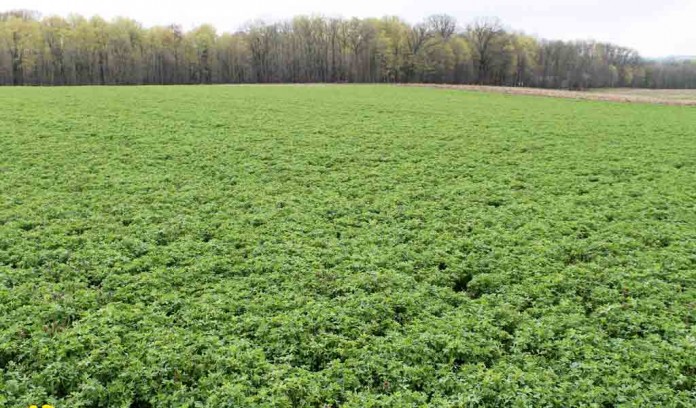As alfalfa stands age, they become thinner. These thinner alfalfa stands allow weeds to encroach the field.
Weeds can also be a problem if they were not properly managed prior or just after seeding the alfalfa.
After the establishment year, the weeds that are most frequent in an alfalfa field include winter annual weeds such as common chickweed, henbit, purple deadnettle, shepherd’s-purse, field pennycress, yellow rocket, birdsrape mustard, bushy wallflower and cressleaf groundsel.
Another group of weeds that can get established are perennial weeds such as quackgrass, dandelion, curly dock and Canada thistle.
Summer annual weeds such as pigweeds and lambsquarters are usually not a problem after the establishment year, but could be.
Reasons to fight weeds
There are three reasons for controlling weeds in alfalfa.
One is the weeds may become dense enough to compete against the alfalfa and reduce yield, although this usually does not happen unless the stand is really thin.
The second reason is to improve forage quality. Many weeds, although not all, have a lower feed value than alfalfa.
Lastly, weeds that are poisonous to livestock need to be removed from the field.
Weeds having low-to-moderate toxicity include yellow rocket, field pennycress, henbit, purple deadnettle and curly dock.
Cressleaf groundsel and poison hemlock are the most poisonous weeds to have in an alfalfa field. Cressleaf groundsel is becoming more prevalent, especially in western Ohio, so be careful.
Timing
The best time to control winter annual weeds and perennial weeds is in the fall when alfalfa is dormant or now — before alfalfa begins to grow in the spring.
Applying herbicides before new growth begins is called a dormant application.
With the current forecast, growth will not begin for some time, but that can change quickly so keeping checking and scouting the field.
Do not apply these products to frozen or snow-covered ground.
What to use
There are only four active ingredients having postemergence and pre-emergence activity on weeds.
These include Velpar (hexazinone), metribuzin, diuron and Sinbar (terbacil).
There are two premix products available to be applied as a dormant application and they are Tripzin ZC (metribuzin plus pendimethalin) and Velpar AlfaMax Gold (hexazinone plus diruron).
Only the metribuzin in Tripzin ZC will control emerged weeds.
The pendimethalin only kills weeds as that are germinating.
Velpar, metribuzin, Velpar AlfaMax Gold and Sinbar are fairly similar in effectiveness at controlling weeds that may be present at this time, although Velpar is a little better on most weeds.
Tripzin ZC has similar activity to metribuzin, except it provides more residual control of grass and small-seeded broadleaf weeds.
Metribuzin controls grasses the least. Sinbar is the weakest on dandelion.
Velpar is a little weaker on henbit than the other two herbicides but is the only one that controls nightshade, although it is not perfect.
Metribuzin and Sinbar are a little more effective on smartweed than Velpar.
Velpar is definitely better on wild radish, although not complete.
Based upon this information, Velpar and Velpar AlfaMax Gold should be the most effective on birdsrape mustard, although I’m sure it is not complete control.
There is little information as to how effective Velpar and metribuzin are at controlling cressleaf groundsel.
I would give a slight edge to Velpar and Velpar AlfaMax Gold compared to metribuzin, and I would expect Sinbar to be less effective.
The Velpar most likely will not provide complete control of cressleaf groundsel.
Use the maximum rates of these herbicides to control the most weeds.
Velpar and Tripzin ZC can be applied to alfalfa having less than two inches of growth in the spring, but injury will occur.
No adjuvants are required with these herbicides.
Metribuzin allows for the greatest rotation to other crops.
Crops can’t be rotated after the application of Velpar, Velpar AlfaMax Gold and Sinbar for two years, except corn, which can be rotated 12 months after Velpar if deep plowed before planting.













